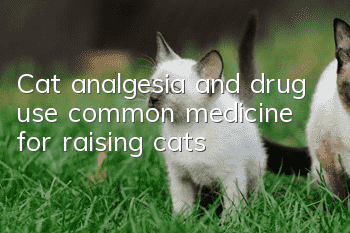Cat analgesia and drug use, common medicine for raising cats!

Cats also need analgesics when they are in pain
Cats’ analgesia and drug use are common medicines for raising cats! The analgesic effect is to make the cat’s pain disappear, and at the same time, the generation of pain will make the cat manic. Restlessness, abnormal behavior, and even aggressive behavior, so analgesics also have a sedative effect. The cause of pain may be inflammation of some organs, lesions, or trauma and collision. Pain is mediated by nerves, so most analgesics have a sedative effect. in the central system.
Analgesics are divided into two types, mainly opioid analgesics and narcotic analgesics. Narcotic analgesics are drugs that can induce sleep or anesthesia while providing strong analgesia. Opioid analgesics can cause sedation and euphoria in cats, are addictive and dependent, and generally do not cause cats to lose consciousness. These drugs can also be used for analgesia, cough and diarrhea.
1. Pharmacokinetics
Analgesic drugs have lipophilic properties and quickly penetrate into most tissues, with higher concentrations in the substantial tissues of internal organs. The concentration in muscle and fat is low, and it can be rapidly metabolized into polar metabolites by the liver and other enzyme systems. Most drugs have maximum effects 30 to 60 minutes after injection, and the duration of action is less than 2 hours in most animals. Occasionally, sedatives are seen. The pain lasts for 4 to 5 hours.
2. Pharmacological effects
For the central system, it mainly has an analgesic effect, which can change the feeling of pain and response, thereby relieving severe, especially dull, long-lasting pain. It can make animals sedated, lethargic and confused, but can wake them up. It has an inhibitory effect on the respiratory center and also has an inhibitory effect on the cough center. After taking the drug, the cat's pupils will dilate, and sometimes nausea and vomiting may occur.
Increased saliva secretion, vomiting and defecation, and constipation are often seen due to contracture of the gastrointestinal tract.
3. Some common analgesics
1. Morphine
This product is commonly used as its hydrochloride, which is white, Mercerized needle-like crystals or crystalline powder; odorless; easily deteriorated when exposed to light. Soluble in water, slightly soluble in ethanol, almost insoluble in chloroform or ether.
Morphine is a powerful analgesic, suitable for acute sharp pain where other analgesics are ineffective, such as severe trauma, war injuries, burns and other pain. , the application of this product can calm animals and reduce the burden on the heart.
Because this product has a strong excitatory effect on smooth muscle, it cannot be used alone for visceral colic (such as biliary colic, etc.), but should be used in combination with effective antispasmodics such as atropine.
Morphine has a powerful central analgesic effect, a wide range of analgesia, and is effective for all kinds of pain. Morphine-like mania in cats can be avoided by administering small doses multiple times or giving diazepam at the same time.
Morphine also has a powerful antitussive effect and affects the temperature regulation center, which can increase the cat's body temperature. Morphine is administered mainly through subcutaneous or intramuscular injection. CatsThe general dosage is 0.5~1mg.
2. Pethidine
Peperidine is also known as meperidine. The pharmacological effects are basically the same as those of morphine. Pethidine is a white crystalline powder, odorless, easily soluble in water or ethanol, soluble in chloroform, and almost insoluble in ether.
The analgesic effect is weaker than that of morphine, its potency is 1/7 to 1/10 of morphine, and its duration of action is shorter than that of morphine, ranging from 2 to 4 hours. The sedative, euphoric, respiratory depression and vasodilatory effects are equivalent to those of morphine.
It can also excite smooth muscles and increase the tension of smooth muscles and sphincter muscles. However, due to its short action time, it is less likely to cause constipation and urinary retention. Large doses of pethidine can also cause bronchial smooth muscle contraction.
It has a slight uterine stimulating effect, but has no effect on the normal contraction of the uterus at the end of pregnancy, and does not oppose the effect of oxytocin, so it does not delay labor.
Peperidine is mainly used for sedative analgesia in cats, or pre-anesthetic administration in cats.
3. Cyclohydromorph
It is an agonist antagonist and can be injected intravenously, intramuscularly, subcutaneously and orally. Cyclohydromorph is used together with The combination of other drugs such as acepromazine, ketamine and xylazine is more than 7 times more effective than morphine. It has a very powerful analgesic effect on the internal organs and has a small inhibitory effect on the heart and lungs.
4. Side effects of analgesics
After using this type of drugs, nausea, vomiting, constipation, lung and liver function damage, and accumulation of phlegm may occur. Urinary and other adverse reactions.
- How to brush your cat’s teeth?
- What is cat triple vaccine?
- How to train a cat after it makes a mistake? Remember these four methods!
- What happens if a cat eats an orange?
- Which Persian cat is the most expensive? What is the market price of Persian cats?
- Why do black calico cats attract wealth?
- Siamese cat appearance characteristics and living habits
- What should you pay attention to before neutering a male cat?
- What are the signs before a cat gives birth?
- What are the signs of cats in heat?



